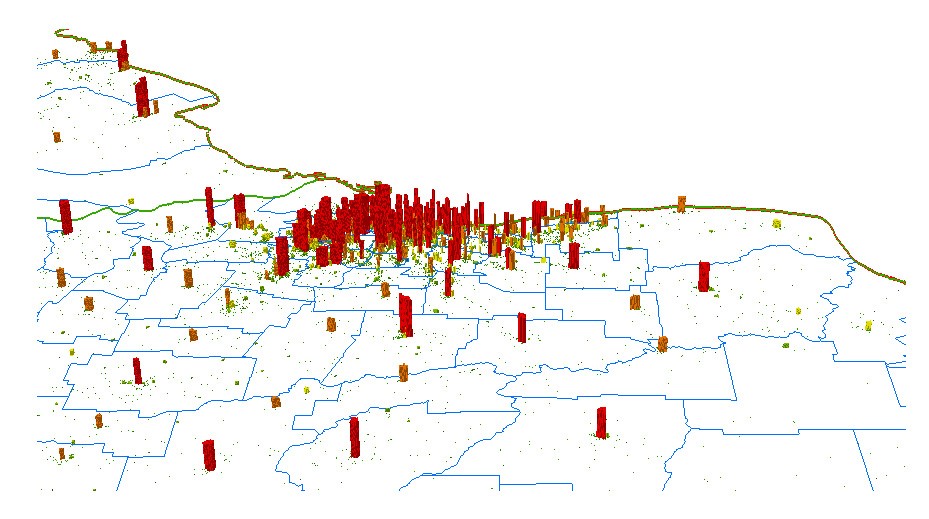PopMaps : Reliable Population Density Maps for Global Telecoms Planning
LuxCarta’s population density maps help you plan telecommunications infrastructure better.

Get a Reliable View of Population Density Anywhere on Earth
When you’re planning telecoms infrastructure, you need a clear and reliable view of where your customers are. Use our population density maps to:

Know market size
Roll out infrastructure using latest census data and accurate estimates about the number of people living in a target market.

Control 5G costs
Wireless equiment is expensive. Our PopMaps mean you install the right amount of hardware, where it’s needed.

Enter emerging markets
From the world’s most populous country to remote island nations, our density maps cover the entire world population.

Manage projects better
Improve project management by prioritizing the work plans of technicians and engineers.

Respond to emergencies
When disaster strikes, PopMaps rapidly tell you how many people live in a specific land area.

Deliver the best service
Improve customer satisfaction by ensuring reliable and consistent coverage everywhere.
Our Unique Approach to Population Density Maps
For over 25 years, LuxCarta has specialized in producing digital maps for the telecommunications industry. Our unique methodology for creating population density maps means you know how many people live in your target market.
It starts with the data
In countries with reliable census data, we populate our density maps using the latest available figures. Our demographics experts extrapolate population trends forward if it has been several years since the last census.
For countries with no (or unreliable) census data, we use proprietary methods to estimate population density. This includes up-to-date satellite imagery of human settlements to estimate the number of people living there.
Detailed Feature Extraction
We extract raster and polygon information about man-made features from satellite imagery. This process enables us to identify and analyze the characteristics and distribution of structures within any settlement. By focusing on the details of these features, including their size, shape, and spatial arrangement, we provide a comprehensive view of the built environment, enhancing land use classification.
We generate easy-to-read maps
Combining population data and building characteristics, we produce a density raster map for each division in a city, suburb or rural area. The density map provides a clear, easy-to-understand representation of the number of people living in each neighborhood or administrative area.
Output you can use
Our PopMap solution is delivered as a global human settlement layer raster file (GRC, ASCII) or vector format (SHP or TAB). This is optimized for speedy processing with all popular GIS mapping software.
A Better Way to Plan Telecom Infrastructure Rollout
Overcome key challenges to telecoms rollout and upgrade projects with a true view of population density in every market. LuxCarta’s population density maps mean you:

Roll out and optimise your network more effectively
The enormous scale of investment in wireless network rollout means waste and redundancy must be avoided. By knowing exactly how many people live in a settlement you can install the right number of base stations and radio towers. No more, no less.
Tackle resource shortages
There is a global shortage of telecom technicians and engineers. Using population density maps in your project planning helps prioritize installations, and means your existing human resources are used as efficiently as possible.
Stop relying on guess work
We estimate population density using a combination of census data and up to date satellite images of settlements to accurately estimate the true size of a market. That means your plans are no longer based on best guesses.
Integrate your Population Density Map With All Planning Technology
List of Integrations: Information on software, tools, and services that the product integrates with, enhancing its utility and flexibility.
Integration Details: Brief explanations of how each integration adds value to the user experience.
Testimonials and Case Studies
Learn how global telecommunications firms are benefiting from LuxCarta’s unique population density map solution.
“We needed a way to show our senior leadership team that marketing was producing results, and that’s hard when your metrics are scattered. This dashboard saved the day.”
“We needed a way to show our senior leadership team that marketing was producing results, and that’s hard when your metrics are scattered. This dashboard saved the day.”
Frequently Asked Questions
We’ve answered common questions about our population density map solution.
What is a population density map?
A population density map is a map which represents the number of people living in a unit of land area. PopMaps use different methods to show how many people live in a selected area, but typically employ color (e.g., red for many people, green for fewer people, yellow for almost no people). Density maps can be generated at any scale, depending on your needs. It’s common to show population by square kilometer, or administrative boundaries (such as zip/postal codes).
How long does it take to produce a population density map?
It depends on the area of land to be included in the map, and the resolution required. At LuxCarta, our highly experienced analysts can produce population density maps for an entrie country in as little as 4 - 5 weeks.
Why do telecom firms need population density maps?
PopMaps provide several key advantages to telecommunications companies. When planning out or upgrading a network, you need to have a good idea of the market size in a destination - population density maps provide invaluable market insights. They are also extremely helpful when planning locations for base stations and cell towers - you need to be sure infrastructure will reach the highest number of customers. And they serve as dynamic tools for capacity management - allowing telecom providers to proactively balance loads based on real-time population patterns.